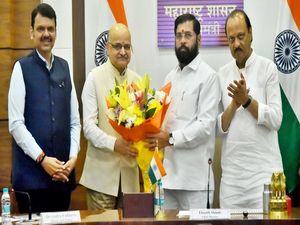Businesses
With momentum broken, market awaits budget announcement
Mumbai, July 21 (IANS) Markets made new intraday highs on the benchmark indices on all four trading sessions of the week. Closing highs were made in the first three sessions and then all hell was let loose on the last trading session which was Friday.
What we saw was probably the first setback after the 4th of June. It broke the back and momentum went for a toss. What next is the question on everybody’s mind?
BSESENSEX gained 85.31 points or 0.11 per cent to close at 80,609.65 points. NIFTY gained 28.75 points or 0.12 per cent to close at 24,530.90 points.
The broader markets saw BSE100, BSE200 and BSE500 lose 0.55 per cent, 0.81 per cent and 1.06 per cent respectively.
BSEMIDCAP was down 2.63 per cent while BSESMALLCAP lost 2.86 per cent. Suffice it to say that the colour of the markets was red on the trading screens. The IT and Tech sectors saved the market somewhat as they were big gainers, while Capital goods and metals were the big losers.
The intraday high made on Friday was 81,587.76 points on BSESENSEX while it was at 24,854.80 points on NIFTY. The losses that the markets suffered on Friday from their intraday highs were almost 1,000 points on BSESENSEX and 325 points on NIFTY.
This kind of fall on virtually the eve of the budget sets up an interesting week with the budget on Tuesday and July futures expiry on Thursday.
Volatility in the markets would rise sharply and there would be plenty of two-sided moves. Markets gained on three of the four trading sessions and lost on one.
The Indian Rupee lost 12 paise or 0.14 per cent to close at Rs 83.66 to the US Dollar. Dow Jones too had a very choppy and volatile week. It gained very sharply in the earlier part of the week and then fell equally sharply.
In a week that saw the Dow gaining on three of the five sessions, we saw the Dow making an intraweek high of 41,221.98 points. Dow closed at 40,287.53 points, a gain of 286.65 points or 0.72 per cent. Here too the reversal was very sharp and hit the markets badly.
What triggered the setback in our markets and globally? People may blame it on the massive outage that took place in Microsoft Edge but that had no relevance. There was chaos in India as well and 100s of flights were cancelled on Friday and partly on Saturday as well. Normalcy returned thereafter. It only shows how vulnerable the world has become.
Results season is on and the outcome is a mixed bag. After TCS results, Infosys results were declared and they were marginally better than the street expected. However, because of negative sentiments in the markets about Infosys, saw its share rise sharply. It gained Rs 81 or 4.73 per cent to close at Rs 1,791. The high it made was Rs 1,842, a loss of Rs 51 from the highs. During the weekend four banks and Reliance Industries have declared results. In the present circumstances these results do not enthuse the markets and they would not be able to change the sentiment and drive markets upwards.
The week ahead sees the budget being presented on Tuesday the 23rd of July. Expectations are that there would be announcement of some freebies and that income tax relief of Rs 50,000 or thereabouts would be announced at the bottom of the pyramid.
Further, there would be some mention of allocation to build the new capital of Andhra Pradesh after Hyderabad became the capital of Telangana. An allocation of special status for Bihar would further dent the resources available.
While the buoyancy of revenue collection and the economy which is in fine fettle would increase allocable money for the FM, it would be a tightrope walk to balance the expectations of all stakeholders. Probably allocation to growth-driven infrastructure could see some hit. All of this could see the budget being a mixed bag from the market’s perspective.
One possible view that emerges post the budget is, that there is no negative surprise and hence it is positive, could rally the markets. Otherwise by and large it could be a neutral budget from the market perspective. In any case, the biggest concern in the markets currently is valuations and they are skewed and tend to be in the expensive and uncomfortable zone.
Post the budget presentation we have July futures expiry on Thursday the 25th of July. The present level of NIFTY at 24,530.90 points is higher by 486.50 points or 2.02 per cent. While the lead favours the bulls currently, the fact that Friday saw an intraday fall of close to 325 points, the lead is not much. Further, the Budget in the middle could see sharp volatility. While currently, the bulls have the upper hand, things could over the next four days change completely.
In primary market news, we have the issue from Sanstar Limited during the week. The issue opened on Friday the 19th of July and would close on Tuesday the 23rd of July. The issue consists of a fresh issue of 4.18 crore shares and an offer for sale of 1.19 crore shares in a price band of Rs 90-95.
The company is in the business of processing maize for use in food, pharma and cattle feed. The PE multiple for the company is between 18.95 to 20.00. The main object of the issue is to increase the present capacity by almost double. This capacity would be available by the end of the current financial year. With present capacity utilisation at a high 80 per cent level, there is little scope for growth in the current year. With dilution, there would be an impact on earnings.
While there is a grey market currently in the shares, they do change as the issue progresses and lists. Investors with a long-term view could take a look at the share once it is listed for some time, and then take a call.
Coming to the markets in the week ahead, expect them to be choppy and volatile with two events ahead. The budget and July futures expiry will keep them in the thick of action. The strategy would be to continue to take money off the table and allow the budget to sink in over the next couple of days.
FPIs have been giving confusing signals with their buying and selling alternating overtime over the last month or six weeks. Geo-political news over the last 24 hours is also a cause of worry. In such a fluid position ahead of important events, it becomes that much more imperative to have a light position and allow events to unfold.
In conclusion, allow events to unfold and then take action. Trade cautiously.
–IANS
arun/dan
Businesses
Investors’ wealth eroded by a massive Rs 9.19 lakh crore

Investors’ wealth eroded by a massive Rs 9.19 lakh crore on Tuesday as markets came under heavy sell-off with the BSE benchmark index Sensex falling 930.55 points.
Extending its previous day’s decline, the BSE Sensex plummeted 930.55 points or 1.15 per cent to settle at 80,220.72. During the day, it tanked 1,001.74 points or 1.23 per cent to 80,149.53.
The market capitalisation of BSE-listed firms eroded by Rs 9,19,374.52 crore to Rs 4,44,45,649.22 crore (USD 5.29 trillion). “There has been no respite from FIIs selling in local equities in the current month so far, which has been creating uncertainty among domestic investors.
Also, foreign investors are fleeing Indian equities to invest in relatively cheaper locations such as China, especially after the stimulus announcement by its government to boost its slowing economy.
“Along with sectoral stocks, mid and smallcap stocks too bore the brunt as persistent buying had led to valuations in several stocks getting expensive and hence the breather,” Prashanth Tapse, Senior VP (Research) at Mehta Equities Ltd, said.
From the 30 Sensex pack, Mahindra & Mahindra, State Bank of India, Power Grid, Tata Steel, IndusInd Bank, Tata Motors, Larsen & Toubro, NTPC, Bajaj Finance and Reliance were among the biggest laggards. In contrast, ICICI Bank, Nestle and Infosys were the gainers from the pack.
Businesses
NITI Aayog shares a $300 billion economy roadmap for Mumbai Metropolitan Region

Mumbai, Aug 22 (IANS) The NITI Aayog in its presentation to the Maharashtra government on Thursday suggested a roadmap for the Mumbai Metropolitan Region (MMR) to become a $300 billion economy by 2030 from the present $140 billion.
NITI Aayog CEO BVR Subrahmanyam during his meeting with Maharashtra Chief Minister Eknath Shinde and Deputy CMs Devendra Fadnavis and Ajit Pawar, suggested that the state can achieve this ambitious target with the promotion of MMR as global services’ hub, affordable housing and slum rehabilitation, tourism, port-proximate integrated manufacturing and logistics hub, planned urbanisation and intensive transport oriented development, sustainability projects and world-class urban infrastructure and transport.
NITI Aayog has said that the state government can attract a private investment of $125-135 billion, incremental GDP growth of $130-150 billion and additional capital by the state government of the order of Rs 50,000 crore over 5-6 years to chase the goal of making MMR a $300 billion economy.
“MMR is a $140 billion economy across 5 districts and covering 9 municipal corporations with a 25.8 million population and 10 million jobs. Good news is that MMR is on a positive growth trajectory on the back of $50 billion ongoing infrastructure investments. Our vision is to grow MMR into a $300 billion economy by 2030 and $1.5 trillion economy by 2047,” said Subrahmanyam in the presentation.
According to NITI Aayog, MMR has a potential to become a global services hub due to the existing two world-class business districts, Wadala and BKC for financial services and after the development of Navi Mumbai Aerocity as a global aviation city.
It has suggested that the rehabilitation of 2.2 million slums will create new housing stocks in addition to around 1 million affordable housing for low income and middle income group segments.
NITI Aayog has suggested the state can promote two themed tourism development hubs at Gorai and Madh and Alibaug and implement a masterplan for a 300 km coastline.
Further, the MMR can promote port proximate integrated manufacturing and logistic hub with the development of Kharbav integrated logistic cluster as a multi-modal logistic park, circular economy parks and electronic manufacturing and manufacturing cluster for white goods assembly at Khalapur-Panvel section.
In the wake of the development of Rs 76,000 crore Vadhavan port, NITI Aayog has suggested that it can be exploited for the promotion of green hydrogen, steel, chemicals, integrated textiles and apparels.
Further, the NITI Aayog has suggested that the government should release a slew of policies for services, tourism, affordable housing, and transport-oriented development. In addition, the government will have to craft investment promotion and land allocation policy, simplified and enabling urban planning policies, women-inclusivity blueprint and Green MMR policy.
Chief Minister Eknath Shinde has said that the government is focusing on the construction of affordable housing, development of a data center in Navi Mumbai, and completion of Alibaug Multimodal Corridor. Recently, the state government has cleared projects with an investment of Rs 80,000 crore. The government has stepped up efforts to promote tourism along the 720 km coastline.
(Sanjay Jog can be contacted at sanjay.j@ians.in)
–IANS
sj/pgh
Businesses
Finance Ministry sees food inflation easing further on back of better monsoon

New Delhi, Aug 22 (IANS) Inflationary pressures in the Indian economy eased in July and food inflation is expected to come down further with this year’s better monsoon leading to higher agricultural production, according to the Finance Ministry’s monthly review released on Thursday.
Retail inflation based on the Consumer Price Index eased from 5.1 per cent in June 2024 to 3.5 per cent in July 2024, the lowest since September 2019.
This was mainly due to a significant fall in food inflation. It declined to 5.4 per cent in July 2024 from 9.4 per cent in June 2024, the review states.
The substantial fall witnessed in food inflation was helped majorly by a decline in vegetable inflation from 29.3 per cent in June 2024 to 6.8 per cent in July 2024 and mild deflation in ‘oils and fats’ and spices.
On the other hand, core inflation (which excludes food and fuel) was at a moderate level of 3.3 per cent in July 2024.
Overall, the retail inflation rate moderated to 4.6 per cent in the first four months of FY25 as compared to 5.3 per cent in FY24 (April-July), according to the review.
With moderate core inflation and positive progress in the monsoon, the headline inflation outlook is positive. Assuming a normal monsoon, CPI inflation for FY25 is projected at 4.5 per cent by the RBI, with Q2 inflation at 4.4 per cent.
A steady progress in the southwest monsoon has supported agricultural activity. The cumulative southwest monsoon rainfall was 3 per cent higher than the long-period average up to August 19, 2024. Further, the spatial distribution has improved, with 84 per cent of subdivisions receiving normal or excess rainfall. This has enabled healthy Kharif sowing.
As of August 16, the actual sowing area under total foodgrains was 4.8 per cent higher than the corresponding period of the previous year, while progress in cereals and pulses was 4.6 per cent and 5.7 per cent higher than the previous year.
Corresponding to healthy progress in monsoon, availability of water level in reservoirs improving, ensuring water adequacy for irrigation during current Kharif and upcoming rabi crop production. The storage availability in 150 reservoirs as of August 15, was 111 per cent of the corresponding period of last year and 114 per cent of the average storage of the last ten years, according to the Central Water Commission. This augurs well for healthy food production that will aid in cooling food inflation in the upcoming months. Further, to enhance productivity and resilience in the agriculture sector, various measures have been announced in the Union Budget FY25, the Finance Ministry said.
–IANS
sps/vd
Businesses
Indian economy is on upswing: Finance Ministry

New Delhi, Aug 22 (IANS) The Indian economy experienced a notable upswing across various economic indicators in July 2024, signalling strong and resilient business activities with both the manufacturing and services sectors posting a robust performance, according to the Finance Ministry’s monthly review released on Thursday.
“The month saw impressive milestones being reached, substantial growth in GST collections, and a significant rise in e-way bill generation, which points to an overall increase in economic activity. The stock market indices also reached record highs in July,” the review states.
On balance, India’s economic momentum remains intact. Despite a somewhat erratic monsoon, reservoirs have been replenished. Manufacturing and services sectors are expanding, going by the Purchasing Managers’ indices. Tax collections – especially indirect taxes, which reflect transactions – are growing healthily, and so is bank credit, according to the review.
Inflation is moderating, and exports of both goods and services are doing better than they did last year. Stock markets are holding on to their levels. Foreign direct investment is looking up as gross inflows are rising, the review states.
Gross GST collections for July 2024 maintained their momentum, achieving their second-highest level since May 2023. The total gross GST revenue rose by 10.3 per cent year-on-year (YoY), bringing the total for FY 25 (April to July) to Rs 7.4 lakh crore.
This increase in GST collections also highlights robust compliance and expansion of GST coverage across various economic activities.
The upward level shift is reflected in the average monthly GST collections rising from Rs 1.68 lakh crore in FY24 to Rs 1.85 lakh crore in FY25.
The year-on-year increase in e-way bills reached a nine-month peak of 19.2 per cent with the total number of e-way bills issued in July surging to 10.5 crore, setting a new single-month record.
According to the review, the manufacturing sector has continued to demonstrate robust performance in the first four months of FY25, as evidenced by the strong performance of various high-frequency indicators.
The Purchasing Managers’ Index (PMI) Manufacturing, a crucial gauge of the economic vitality of the manufacturing sector, stood at 58.1 in July 2024, significantly above the series long-run average and among the highest recorded in recent years. This expansion, driven by buoyant demand conditions and a surge in production volumes, bodes well for the overall health of the economy.
Similarly, the service sector continued to perform well.
PMI services remained in an expansionary zone at 60.3 in July 2024, driven by expansion in international sales, an increase in new order uptakes, and a rise in new export orders.
Despite a rise in wages and material costs which pushed up business expenses, overall sentiment in the services sector remains upbeat, driven, among others, by an upswing in the tourism cum hotel industry induced by leisure travel, business travel, and social events, the Finance Ministry said.
–IANS
sps/pgh
Businesses
Sensex closes 147 pts up 81,053, Nifty above 24,800

Mumbai, Aug 22 (IANS) Indian stock markets again closed higher on Thursday due to positive sentiment in the markets.
At closing, Sensex was up 147 points, or 0.18 per cent, at 81,053 and Nifty was up 41 points or 0.17 per cent at 24,811.
The market’s positive sentiment was bolstered by optimistic global cues, particularly from the US markets, where the S&P 500 extended its winning streak, reflecting investor confidence amid expectations of potential interest rate cuts by the Federal Reserve.
During the day, Sensex traded in the range of 80,954 to 81,236 and Nifty traded in the range of 24,784 to 24,867.
In the Sensex pack, Bharti Airtel, Tata Steel, ICICI Bank, Titan, Asian Paints, UltraTech Cement, JSW Steel, Maruti Suzuki and SBI were the top gainers. Tata Motors, M&M, Wipro, NTPC, TCS, Power Grid, Sun Pharma, Axis Bank, and Nestle are the top losers.
Thursday’s market rally was led by Nifty Bank which settled up 300 points or 0.59 per cent at 50,985.
Among the sectoral indices, PSU Bank, fin service, FMCG, metal, realty and Private bank were the major gainers. Pharma, IT and energy were the major laggards.
An upward trend was also seen in small and medium stocks in the trading session. The Nifty midcap 100 index was up 400 points or 0.69 per cent at 58,844 and the Nifty smallcap 100 index was at 19,099, up 32 points or 0.17 per cent.
According to market experts, the domestic market witnessed modest gains owing to positive global sentiments.
“Particularly, the recent signs of weakness in the US non-farm payroll data have strengthened the case for potential interest rate cuts in September. However, in the broader market, investors are being cautious, opting for a selective approach, awaiting more clarity from central bank leaders in Japan and the US,” they added.
–IANS
avs/vd
-
Video2 years ago
PM Modi Attacks Congress in Karnataka with “Kerala Story”
-
Politics2 years ago
Siddaramaiah & DK Shivakumar sworn in as Chief Minister & Deputy CM respectively
-
Cricket2 years ago
CSK players rejoice 5th IPL title with their families (Pics)
-
Entertainment2 years ago
Karan Deol weds his longtime Girlfriend Drisha Acharya (Pics)
-
Sports7 years ago
History Of Official FIFA WORLD CUP Match balls
-
India2 years ago
Ashwini Vaishnaw: Railway Board recommends CBI probe in the Odisha railway disaster
-
Entertainment2 years ago
Urvashi Rautela dazzles on Cannes 2023 red carpet (Pics)
-
Entertainment2 years ago
Sunny Leone gets ready for Kennedy premiere in Cannes (Pics)































